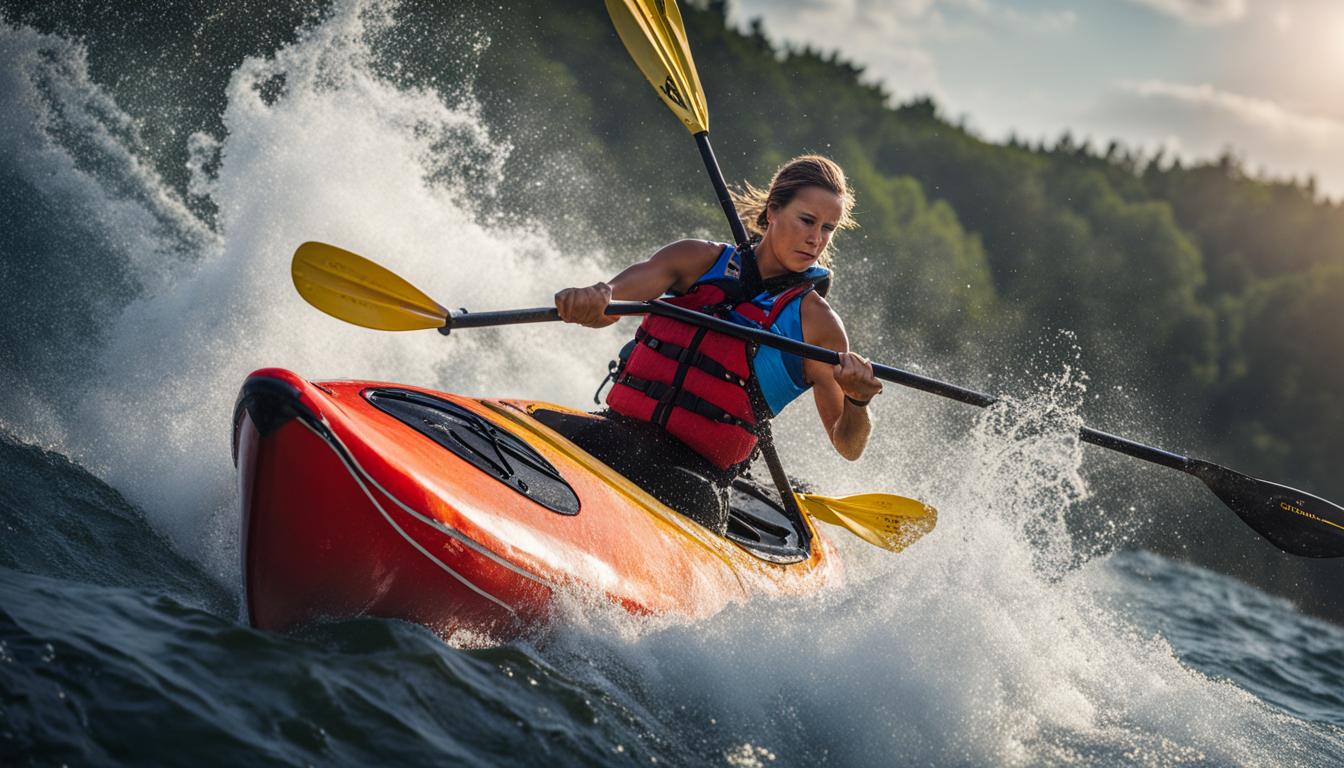In the world of kayaking, balance and control are paramount. And at the core of it all lies the importance of core stabilization. Whether you’re a beginner or an experienced paddler, understanding and incorporating core stability exercises into your training routine can have a significant impact on your performance.
Core stability, often mistakenly associated solely with abdominal muscles, encompasses a range of deep muscles, including the pelvic floor and inner thigh muscles. By targeting these muscles, you can enhance your balance, prevent back pain, and stabilize your movements while riding the waves.
To achieve core stability in kayaking, it’s crucial to engage in exercises that strengthen and stabilize these deep muscles. Planking and stability ball workouts are just a couple of examples that can help you achieve your goals.
Key Takeaways:
- Core stabilization is crucial for maintaining balance and control in kayaking.
- It involves targeting deep muscles, not just the abdominal muscles.
- Exercises like planking and stability ball workouts can improve core stability.
- Core stabilization enhances balance, prevents back pain, and stabilizes movements during surfing.
- By incorporating core stability exercises into your routine, you can enhance your kayaking performance.
The Importance of Core Stability for Paddling
When it comes to kayaking, core stability is not just a nice-to-have; it is an essential component of a successful paddling technique. Your core muscles provide the foundation for balance, control, and power in the boat, allowing you to maneuver through the water with efficiency and precision.
Poor core stability can lead to inefficient paddle strokes, decreased control over the kayak, and an increased risk of injuries such as back pain. On the other hand, a strong and stable core allows you to generate more force in your strokes, maintain balance in challenging conditions, and improve overall paddling performance.
By focusing on improving your core stability, you can enhance your abilities as a paddler. Engaging in core-strengthening exercises specific to kayaking, such as rotational movements and anti-rotation exercises, can help you develop the necessary strength and stability to excel in the sport. Additionally, incorporating balance training into your routine can further enhance your core stability, as well as your overall body awareness and coordination.
Remember, core stability is not just about having a six-pack; it encompasses the deeper muscles of your core that provide the foundation for movement and stability. By prioritizing core stability in your training, you can maximize your paddling potential and enjoy a more efficient and enjoyable kayaking experience.

Table: Core Stability Exercises for Paddlers
| Exercise | Description |
|---|---|
| Planking | A static exercise that targets the entire core, including the abdominal muscles, back muscles, and stabilizing muscles. |
| Side Plank | A variation of the plank that targets the obliques and improves lateral core stability. |
| Woodchopper | A dynamic exercise that mimics the movement of paddling and enhances rotational core strength. |
| Bird Dog | A stability exercise that challenges balance and core control, helping to stabilize the kayak during dynamic movements. |
| Stability Ball Rollout | An advanced exercise that targets the deep core muscles and improves overall core stability. |
These exercises are just a starting point, and there are many other core stability exercises that can benefit paddlers. Consult with a qualified trainer or coach to create a personalized training program that addresses your specific needs and goals as a kayaker.
Core Stabilization Exercises for Paddlers
Core stabilization exercises are essential for kayakers as they help improve balance, control, and overall paddling performance. Incorporating these exercises into your training routine can enhance core strength, stability, and endurance. Here are some effective core stabilization exercises specifically designed for kayakers:
1. Planking Variations:
Planking is a versatile exercise that targets the deep core muscles and promotes stability. Variations of planks, such as forearm planks, side lying planks, and planks on stability balls, provide a challenging workout for the entire core. Start with a basic plank position and gradually progress to more advanced variations.
2. Stability Ball Pikes:
Stability ball pikes engage the core and strengthen the muscles necessary for paddling. Begin in a push-up position with your feet resting on a stability ball. Slowly lift your hips and roll the ball towards your hands, creating a pike position. Return to the starting position and repeat for a full set.
3. Reverse Planks:
Reverse planks target the posterior chain and help develop core strength. Sit on the ground with your legs extended in front of you and your hands placed behind your hips. Press through your palms and lift your body, creating a straight line from head to toe. Hold this position for a set amount of time or repetitions.
Remember to perform these exercises with proper form and gradually increase the intensity as your core strength improves. Consistency is key to seeing results, so aim to incorporate these exercises into your training routine at least two to three times a week. By focusing on core stabilization, you’ll enhance your paddling abilities and enjoy a more efficient and enjoyable kayaking experience.
The Physical Benefits of Core Stabilization in Kayaking
When it comes to kayaking, core stabilization offers a multitude of physical benefits. One of the key advantages is its impact on weight management. Kayaking is a calorie-burning activity that engages the core muscles. By incorporating core stability exercises into your training regimen, you can effectively burn calories and maintain a healthy weight.
In addition to weight management, core stabilization also plays a crucial role in developing upper body strength. Paddling requires the use of muscles in the arms, shoulders, and back, and a strong core provides a stable foundation for generating power in these areas. By improving core stability, you can enhance your overall upper body strength, leading to better performance on the water.
Furthermore, core stability directly contributes to improved endurance. Engaging your core muscles during paddling not only helps generate more power, but it also reduces the risk of fatigue. This allows you to paddle for longer durations without experiencing excessive tiredness, enabling you to explore more waterways and enjoy extended kayaking sessions.
| Physical Benefits of Core Stabilization |
|---|
| Weight management through calorie burning |
| Enhanced upper body strength |
| Improved endurance and reduced fatigue |
By prioritizing core stabilization in your kayaking training, you can unlock these physical benefits and take your paddling to the next level. Whether you’re a beginner or an experienced kayaker, incorporating core stability exercises into your routine can make a significant difference in your overall performance and enjoyment of the sport.
The Mental Benefits of Core Stabilization in Kayaking
Aside from the physical advantages, core stabilization in kayaking also provides significant mental benefits. Engaging in this sport releases neurotransmitters like serotonin, dopamine, and endorphins, which have a positive impact on mood and overall well-being. The surge of these neurotransmitters can make kayakers feel happier, more satisfied, and more confident in themselves.
In addition to boosting mood, core stabilization in kayaking also improves focus and concentration. The release of neurotransmitters enhances mental clarity, allowing paddlers to stay more present and focused during their kayaking sessions. This increased focus can lead to better performance, better decision-making, and a more enjoyable experience on the water.
Regular practice of kayaking and core stabilization exercises can also have long-term mental health benefits. It has been shown to improve memory and cognitive function, as well as contribute to better sleep. Having a well-rested mind and improved memory can help paddlers maintain mental sharpness and perform better not only in their kayaking endeavors but also in their daily lives.

The Power of Core Stability
“Kayaking has been my go-to activity for mental relaxation and rejuvenation. It helps me clear my mind and refocus. The combination of being out on the water and engaging my core muscles makes me feel strong, balanced, and at peace.” – Jane, avid kayaker
In conclusion, core stabilization in kayaking not only enhances physical performance but also provides substantial mental benefits. The release of neurotransmitters improves mood, focus, and cognitive function, leading to better mental well-being overall. Regular practice of kayaking and core stabilization exercises can have a positive impact on memory, sleep quality, and overall mental clarity. So, if you’re looking for a sport that not only strengthens your body but also invigorates your mind, kayaking with a focus on core stability is the perfect choice.
Conclusion
Core stabilization is crucial in kayaking, providing numerous benefits for paddlers. By focusing on core strength and stability, you can significantly enhance your balance, power, and control in the boat.
Incorporating core stabilization exercises into your regular training routine is essential. These exercises, such as planking and stability ball workouts, target the deep core muscles and help develop strength and stability from within.
Not only does core stabilization improve your paddling technique and performance, but it also offers both physical and mental benefits. By engaging your core muscles during kayaking, you can burn calories, tone your upper body, and improve overall endurance.
Moreover, core stabilization has a positive impact on your mental well-being. Kayaking releases neurotransmitters that boost your mood, improve focus and attention, and contribute to better sleep. By prioritizing core stability, you unlock your full potential as a kayaker and enhance your overall well-being.
FAQ
What is core stabilization and why is it important in kayaking?
Core stabilization refers to the strengthening and stabilizing of the muscles in the core, including the abdominal muscles, pelvic floor, and inner thigh muscles. It is important in kayaking as it helps maintain balance and control in the boat, prevents back pain, and aids in stabilizing movements during surfing.
What exercises can I do to improve core stability for kayaking?
Some effective core stabilization exercises for kayakers include planking, stability ball workouts, pikes on stability balls, and reverse planks. These exercises target the core muscles and help develop strength and stability.
What are the physical benefits of core stabilization in kayaking?
Core stabilization in kayaking offers several physical benefits, including weight management, enhanced upper body strength and muscle tone, toned legs, and improved endurance. Engaging the core muscles during paddling allows for more power and reduces the risk of fatigue.
How does core stabilization in kayaking affect mental well-being?
Kayaking releases neurotransmitters like serotonin, dopamine, and endorphins, which boost mood and self-confidence. Core stabilization exercises also improve focus, attention span, memory, and promote better sleep, contributing to overall mental health.
How can improving core stability enhance my paddling technique and performance?
By incorporating core stabilization exercises into your training routine, you can enhance your core strength and stability, leading to better balance, power, and control in the boat. This ultimately improves your paddling technique and performance.





